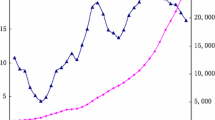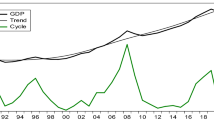Abstract
China initiated economic reform in various sectors from 1978 and since the early 1990s has drawn a great deal of attention to its outward-oriented economic reforms. The economic transition from a centrally planned to a market-oriented system accompanied fluctuations in income distribution. The main objective of this chapter was to examine the impact of China’s outward orientation (globalisation) on income inequality from 1978 to 2007 by using the cross-sectional and time series approach. The major results show that (1) income inequality was widening in the 1990s, especially in the eastern region, which coincided with the period of all round economic reform and accelerated outward-oriented reforms; (2) the reforms of trade and state owned enterprises lead to income inequality, whereas, FDI and economic growth improved income inequality; (3) the eastern region dominated the inequality-increasing effect of trade and inequality-decreasing effect of FDI; and (4) the reform package introduced in 1992 played an important role in the overall inequality-increasing effect. The policy implication is that FDI and trade policies should be strengthened in those regions and sectors that are less developed and/or concerned.
Dr. Shao-Wei Lee is a Research Fellow at the Taiwan Academy of Banking and Finance, Taipei, Taiwan. This research project is originated and re-written based on her unpublished PhD thesis which was completed in Nov. 2010 at the University of Wollonging in Australia.
Access this chapter
Tax calculation will be finalised at checkout
Purchases are for personal use only
Similar content being viewed by others
Notes
- 1.
Based on the poverty headcount ratio of $1.25 a day, the aggregate absolute poverty decreased from 60 % of the population in 1990 to 16 % in 2005 in China (World Bank 2009).
- 2.
Fourteen coastal cities are including Shanghai, Tianjin, Dalian (Liaoning province), Qinghuangdao (Heibei province), Yantai (Shandong province), Qingdao (Shandong province), Lianyungang (Jiangsu province), Nantong (Jiangsu province), Ningbo (Zhejiang province), Wenzhou (Zhejiang province), Fuzhou (Fujian province), Guangzhou (Guangdong province), Zhanjiang (Jiangsu province), Beihai (Guangxi province).
- 3.
The three regions are defined officially by the Chinese government. The eastern region contains Beijing, Tianjin, Hebei, Liaoning, Shanghai, Jiangsu, Zhejiang, Fujian, Shangdong, Guangdong, Guangxi, and Hainan. The central region contains Shanxi, Inner Mongolia, Jilin, Heilongjiang, Anhui, Jiangxi, Henan, Hubei, and Hunan. The western region contains Chongqing, Sichuan, Guizhou, Yunnan, Tibet, Shaxxi, Gansu, Qinghai, Ninghai, and Xinjiang.
- 4.
- 5.
Refer to Chapter Five in Lee (2011) for fuller discussions.
- 6.
GDP data for Hainan is incomplete and withdrawn from this analysis.
- 7.
Take FDI for example, regional FDI is calculated as a ratio of FDI in the a region to total GDP.
- 8.
As mentioned earlier, the panel data regression in this chapter controls for time-invariant region-specific characteristics. That is, fixed effects (group dummies) control for the average difference across regions. This will reduce the problem of omitted variable bias. The consequence of using national data for the inflation rate is that regional-specific differences in inflation rates will only be taken into account without omitted variable bias if the differences are constant. If not, then the estimated coefficient on the inflation rate may be biased.
- 9.
For example, the essential component of the regional labour force and unemployed population are not available. As for inflation, the use of an aggregate measure may lead to a biased parameter estimate.
- 10.
The panel LM unit root test assumes Model AA (which allows two breaks in the intercept) only. In this test, all variables were time demeaned, as if including time fixed effects in usual panel models. This can reduce the cross correlation problems, if they exist.
- 11.
The Davidson-Mackinnon test (1993) examines whether potential endogenous regressors are correlated with the error terms. Rejection of the null hypothesis indicates that the regressors are endogenous and instrumental variables techniques are required. Further to this, the test of validity for the possible instrumental variables including the over-identification, weak-identification, and under-identification tests are used. The over-identification test uses the Sargan-Hansen Statistic with a null hypothesis of the instrument is valid and uncorrelated with the error term. The weak-identification test is undertaken using the Cragg-Donald F statistic, which tests the null hypothesis that the endogenous variables are weakly correlated with their instruments. Lastly, the under identification test by Anderson’s canon correlation likelihood ratio (LR) statistic examines the null hypothesis that the endogenous variables are not correlated with the instruments in the equation.
Abbreviations
- ADF:
-
Augmented Dickey-Fuller
- FDI:
-
Foreign Direct Investment
- FIEs:
-
Foreign-Invested Enterprises
- GDP:
-
Gross Domestic Product
- HOS:
-
H-O model and Stolper-Samuelson theorem
- IPS:
-
Im Pesaran, and Shin
- LLC:
-
Levin Lin, and Chu
- LM:
-
Liquidity preference Money supply
- SEZs:
-
Special Economic Zones
- SOEs:
-
State-Owned-Enterprises
References
Ahmad AH, Daud SNM (2008) Does globalisation promote economic growth and improve income inequality in Malaysia? Empir Econ Lett 7(1):79–87
Ashby NJ, Sobel RS (2008) Income inequality and economic freedom in the U.S. states. Public Choice 134:329–346
Bahmani-Oskooee M, Hegerty SW, Wilmeth H (2008) Short-run and long-run determinants of income inequality: evidence from 16 countries. J Post Keynes Econ 30(3):463–484
Barlow D, Grimalda G, Meschi E (2009) Globalisation vs internal reforms as factors of inequality in transition economies. Int Rev Appl Econ 23(3):265–287
Behrman JR, Birdsall N, Szekely M (2000) Economic reform and wage differentials in Latin America. Working papers, Inter-American Development, Research Department
Berthelemy JC, Demurger S (2000) Foreign direct investment and economic growth: theory and application to China. Rev Dev Econ 4(2):140–155
Bhandari B (2007) Effect of inward foreign direct investment on income inequality in transition countries. J Econ Integr 22(4):888–928
Bhatta SD (2002) Has the increase in world-wide openness to trade worsened global income inequality. Pap Reg Sci 82(2):177–196
Borensztein E, DeGregorio J, Lee JW (1998) How does foreign investment affect growth? J Int Econ 45:115–135
Breau S (2007) Income inequality across Canadian provinces in an era of globalisation: explaining recent trends. Can Geogr 51(1):72–90
Carkovic M, Levine R (2002) Does foreign direct investment accelerate economic growth? Mimeo, University of Minnesota
Chai CH, Roy KC (2006) Economic reform in China and India. Edward Elgar, Cheltenham
China Statistical Yearbook (various issues). National Bureau of Statistics, Beijing
Comprehensive statistical data and materials on 55 years of new China (2005) National Bureau of Statistics, Beijing
Davidson R, MacKinnon JG (1993) Estimation and inference in econometrics. Oxford University Press, New York
Ding S, Dong XY, Li S (2009) Women’s employment and family income inequality during China’s economic transition. Fem Econ 15(3):163–190
Fan CC, Sun M (2008) Regional inequality in China, 1978–2006. Eurasian Geogr Econ 49(1):1–20
Feltenstein A, Iwata S (2005) Decentralization and macroeconomic performance in China. J Dev Econ 76(2):481–501
Fung KC, Iizaka H, Tong SY (2004) FDI in China: policy, recent trend and impact. Glob Econ Rev 32(2):99–130
Gourdon J, Maystre N, De Melo J (2008) Openness, inequality, and poverty: endowments matter. J Int Trade Econ Dev 17(3):343–378
He Z, Tan D (2003) Openness and income inequality: evidence from China. World Econ Study 38–43 (in Chinese)
Huang T, Hu Y, Hu X (2006) An analysis of regional Gini coefficient of per capita GDP. Manage World 5:45–51 (in Chinese)
Im KS, Lee JS, Tieslau M (2005) Panel unit-root tests with level shifts. Oxf Bull Econ Stat 67(3):393–419
Jalilian H, Weiss J (2002) Foreign direct investment and poverty in the ASEAN region. ASEAN Econ Bull 19(3):231–253
Jin F (2009) Foreign direct investment and income inequality in China. Seoul J Econ 22(3):311–340
Kanbur R, Zhang X (2005) Fifty years of regional inequality in China: a journey through central planning, reform, and openness. Rev Dev Econ 9(1):87–106
Keng CW (2004) China’s unbalanced economic growth. Himalaya Foundation, Taipei (in Chinese)
Lee SW (2011) The impact of outward-oriented economic reforms on income inequality in China. PhD thesis, The University of Wollongong, Australia
Lee J, Strazicich MC (2003) Minimum LM unit root test with two structural breaks. Rev Econ Stat 85:1082–1089
Li W, Xu B (2003) Trade, foreign investment, and China’s wage inequality. University of Florida, Retrieved from http://www.ceibs.edu/faculty/xubin/China03.pdf
Lin Y, Liu P (2005) Development strategies and regional income disparities in China. Working paper series, China Center for Economic Research, Peking University
Liu Z (2001) The effects of economic reforms on wage inequality: some evidence from China. Appl Econ Lett 8(4):285–288
Lo CP, Fung KC (2009) Wage inequality, outsourcing, and education. J Int Global Econ Stud 2(1):1–17
Lu X (2008) Income distribution, effective factor endowments and trade openness: a study based on provinces panel data. J Quant Tech Econ 4:53–64 (in Chinese)
Lu M, Wang E (2002) Forging ahead and falling behind: changing regional inequality in post-reform China. Growth Change 33(1):42–71
Lundberg GS, Squire L (2003) The simultaneous evolution of growth and inequality. Econ J 113(487):326–344
Okushima S, Uchimura H (2006) How does the economic reform exert influence on inequality in urban China? J Asia Pac Econ 11(1):35–58
Owen AL, Yu BY (2003) Wage inequality between skilled and unskilled workers in China. Working papers, Hamilton College
Owen AL, Yu BY (2008) Regional differences in wage inequality across industries in China. Appl Econ Lett 15(2):113–116
Ramanathan R (2002) Introductory econometrics with applications. South-Western, Ohio
Reuveny R, Li Q (2003) Economic openness, democracy, and income inequality. Comp Pol Stud 36(5):575–601
Roine J, Vlachos J, Waldenstrom D (2009) The long-run determinants of inequality: what can we learn from top income data. J Public Econ 93(7–8):974–988
Savvides A (1998) Trade policy and income inequality: new evidence. Econ Lett 61:365–372
Silva JA (2007) Trade and income inequality in a less developed country: the case of Mozambique. Econ Geogr 83(2):111–136
Spilimbergo A, Londono JL, Szekely M (1999) Income distribution, factor endowments, and trade openness. J Dev Econ 59:77–101
Stolper WF, Samuelson PA (1941) Protection and real wages. Rev Econ Stud 9:58–73
Sylwester K (2005) Foreign direct investment, growth and income inequality in less developed countries. Int Rev Appl Econ 19(3):289–300
Tian X, Wang B, Dayanandan A (2008) The impact of economic globalisation on income distribution: empirical evidence in China. Econ Bull 4(35):1–8
Wan GH, Lu M, Chen Z (2007) Globalisation and regional income inequality: empirical evidence from within China. Rev Income Wealth 53(1):35–59
Wang S (2007) Openness and income inequality in China: empirical analysis based on panel data. World Econ Study 4:16–21 (in Chinese)
Warr PG (2006) Poverty and growth in Southeast Asia. ASEAN Econ Bull 23(3):279–302
Winters AL, McCulloch N, McKay A (2004) Trade liberalization and poverty: the evidence so far. J Econ Lit 42(1):72–115
Wooldridge JM (2002) Econometric analysis of cross section and panel data. MIT Press, Cambridge, MA
World Bank (2009) Data retrieved February 13, 2009, from World Development Indicators Online (WDI) database
Xu LC, Zou HF (2000) Explaining the changes of income distribution in China. China Econ Rev 11:149–170
Yao S (1999) On the decompositions of the Gini coefficient by population class and income source: a spreadsheet approach. Appl Econ 31(10):1249–1264
Zhang Z (2001) China’s exchange rate reform and exports. Econ Plan 34:89–112
Zhang KH (2006) Does international investment help poverty reduction in China? Chin Econ 39(3):79–90
Zhao Y (2001) Foreign direct investment and relative wages: the case of China. China Econ Rev 12(1):1–18
Zhao Y (2003) Openness and income distribution. World Econ Forum 4:55–70 (in Chinese)
Author information
Authors and Affiliations
Corresponding author
Editor information
Editors and Affiliations
Rights and permissions
Copyright information
© 2014 Springer-Verlag Berlin Heidelberg
About this chapter
Cite this chapter
Lee, SW. (2014). The Impact of Outward-Oriented Economic Reform on Income Inequality in China: 1978–2007. In: Cheng, Z., Wang, M., Chen, J. (eds) Urban China in the New Era. Springer, Berlin, Heidelberg. https://doi.org/10.1007/978-3-642-54227-5_1
Download citation
DOI: https://doi.org/10.1007/978-3-642-54227-5_1
Published:
Publisher Name: Springer, Berlin, Heidelberg
Print ISBN: 978-3-642-54226-8
Online ISBN: 978-3-642-54227-5
eBook Packages: Business and EconomicsEconomics and Finance (R0)




